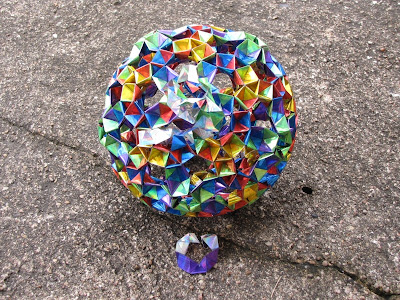An old friend contacted me months ago and asked me to design him something based on his favourite polyhedron, the Pentagonal Hexecontahedron. I'd never even heard of this shape, but I love a challenge & agreed to come up with something.
After weeks of drawing and thinking very hard, this is what I came up with. The squiggly line in the upper-right is the path that one strip takes through the shape. Below that I've drawn a single face - the numbers correspond to the path drawing and show how the strip passes through each face in order. The column in the middle shows how I've divided the full strip into its components: the full length of 76 triangles is far too long so I divided it into 4 subunits. A = red, B = blue, C = yellow, D = green. E strips are purple, and aren't a component of the long strips.
Once the design was finished, it was time to get folding! It took me weeks to fold 20 sheets, each having 16 strips. I needed 300 strips in all (I wound up with 20 extra strips - never hurts to have backups).
Here's the first unit (of 60), front & back view. The tape was needed to hold it together during construction, but isn't present in the final model.
Three units finished.
Six units, front & back.
Nine units.
Here are 14 units - I decided to switch to a pentagonal face, rather than a triangular face as I had been doing.
20 units, and 2 pentagonal faces done.
Halfway done, with 30 units! I really like the inside view.
40 & 50 units. Getting close..
55 units - no tape is left, as it's not needed; the strips can't fly apart anymore.
Just one piece left to add!
4 months later, it's finished. By far the most complex & difficult thing I've made, but it was worth it!



















That is both non-intuitive and impressive. I had been planning to make the individual "cups" by folding and then glue them together into a hollow ball. Your no-glue solution is altogether more impressive.
ReplyDeleteOut of curiosity, how much does the final shape weigh?